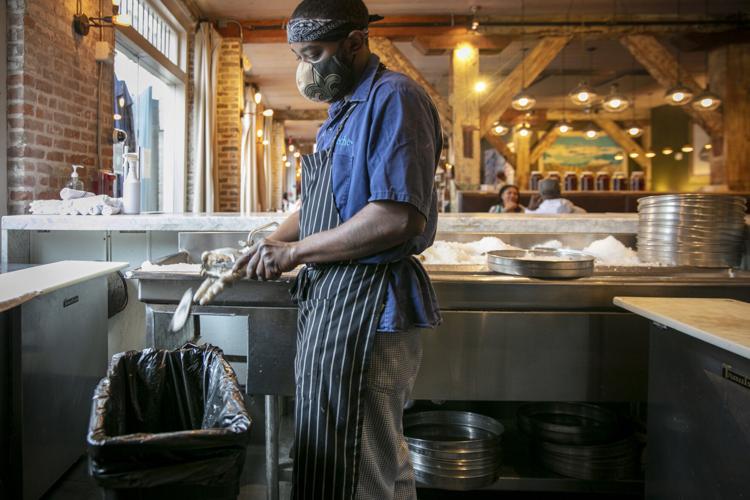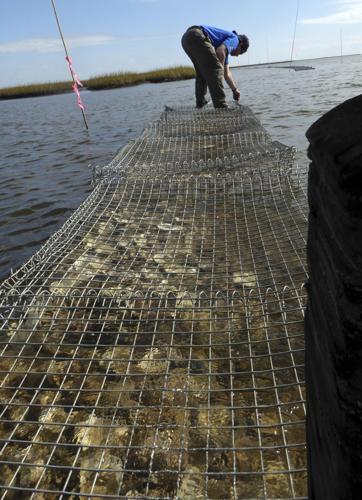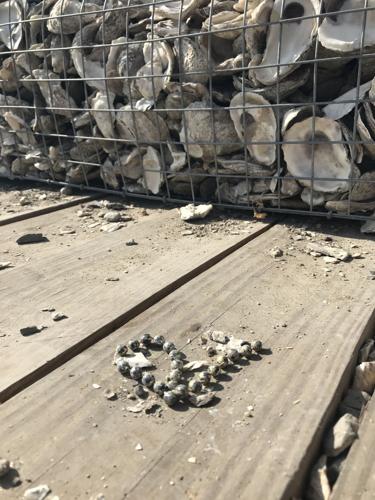In an eroding bay south of New Orleans, where the sea is rapidly claiming land, your dinner leftovers were being stacked into an 800-ton wall nearly a mile long.
The shells of oysters, shucked or slurped at the city’s restaurants, are the raw material for this bulwark against waves, storms and rising seas.
“It’s crazy to think each one of these was on someone’s plate,” coastal restoration specialist Deb Visco Abibou said, as shells packed tight in metal cages were hoisted from a barge and plopped into the shallow waters of Barataria Bay. “It always surprises me that they don’t smell more like garlic.”

Oyster shells from New Orleans restaurants crowd a metal cage that will be stacked into an artificial reef in Barataria Bay. (Photo by Tristan Baurick, The Times-Picayune | The New Orleans Advocate)
The shells are cast-asides from the heady days before the coronavirus pandemic, back when New Orleans’ vaunted seafood restaurants were crammed with customers. The eateries were producing about 75 tons of shells per month for the Coalition to Restore Coastal Louisiana, which runs New Orleans' 7-year-old oyster recycling program.
The vast majority of oyster shells taken from the Gulf of Mexico never make it back. Instead, they end up in landfills or get crushed into chicken feed or road bed material.
“It’s the raw material of Louisiana, and it should be going back out here — not the dump,” Kimberly Davis Reyher, the coalition's executive director, said while watching the Barataria reef’s construction.

Locations of the Coalition to Restore Coastal Louisiana's current and planned artificial oyster reefs. The reefs are made from recycled oyster shells from New Orleans restaurants.
The coalition has built three artificial reefs with recycled oyster shells, including the new one in Barataria, finished in late 2020. At least two more were planned, but then the coronavirus arrived, shutting down restaurants and halting the supply of shells.
“Pre-pandemic, we had almost 20 restaurants producing shells for us,” coalition scientist Christa Russell said. “Then suddenly nothing.”
Now, after a hiatus almost a year long, the program is slowly coming back, as some restaurants reopen with limited menus and seating. The coalition's purple recycle bins went back out to seven restaurants early this month. Pêche, a seafood restaurant in the Warehouse District, had been clamoring for the recycling program’s revival.

Chef Ryan Prewitt of Peche in New Orleans stands alongside his oyster shell recycling bins. (Photo by Chris Granger | The Times-Picayune | The New Orleans Advocate)
“There’s pent-up demand for oysters,” Pêche chef Ryan Prewitt said. “It’s great (the program) is back and we don’t have to throw our shells in the trash. It’s a natural resource that shouldn’t be wasted.”
About 85 percent of the world’s oyster reefs have disappeared over the past 200 years. Louisiana’s once-vast reefs, infamous for shredding the hulls of wooden ships, were decimated first by overharvesting then by levees and diverted freshwater, which skewed salinity levels and caused huge die-offs. BPs’ Deepwater Horizon oil disaster in 2010 dealt another blow, killing an estimated 8.3 billion oysters across the Gulf of Mexico.
Oysters shells are key to producing more oysters. Young oysters need something to latch on to, and their strong preference is the shells of other oysters. As oysters grow, they form reefs that provide a range of benefits.
Out in Barataria Bay, where @CRCL1988 is building oyster reefs to slow coastal erosion and restore habitat. pic.twitter.com/hJdAOnr5fK
— Tristan Baurick (@tristanbaurick) August 20, 2020
“Oysters are both habitat and a fishery,” said Seth Blitch, the The Nature Conservancy’s director of coastal conservation in Louisiana. “It’s a humongous livelihood here and a big part of our heritage and culture.”
They form three-dimensional habitat supporting a host of other species, from blue crab to redfish. They also act as natural water filters, cleansing the Gulf of excess sediment and nitrogen. Oyster reefs also act as speed bumps to slow storms before they hit land, Reyher said.
“For us in New Orleans, they’re an important line of defense,” she said.

Mark Gagliano of Coastal Environments loads gabion cages full of recycled oyster shells at a reef construction site in Barataria Bay. (Photo by Tristan Baurick, The Times-Picayune | The New Orleans Advocate)
Building walls
Louisiana has dozens of artificial oyster reefs. Many were built by the state Department of Wildlife and Fisheries or other nonprofit groups like The Nature Conservancy, which has constructed more than six miles of reef and is planning another mile in Calcasieu Lake.
But rock and concrete have become the go-to material for oyster reefs. Those work, but recycled shell is the gold standard.
“Really, nothing’s better,” Blitch said. “But it’s so incredibly expensive.”

Steve Pettus, managing partner in Dickie Brennan & Co., bags oyster shells during a work party in Buras in 2015. The shells were collected from New Orleans area restaurants including Dickie Brennan & Co., for use in building an oyster reef.
Oysters shells are costly to gather, process and transport, and there are competing markets for the natural material.
“Shells are a commodity,” Blitch said. “Much of it’s going to chicken feed and other uses. For [The Nature Conservancy] reefs, it’s 90% rock because that’s what we can get.”
The Coalition to Restore Coastal Louisiana's oyster recycling and reef-building program is the only large one in the state, and one of the few in the country. Recycle bins are emptied three times a week, and the shell is delivered to the coalition's shell curing site in St. Bernard Parish. After sitting in the sun for several months, the shells are bagged or loaded into cages, known as gabions, then stacked on shorelines. It’s complex, time-consuming and expensive, but it gets results, Russell said.

Volunteers add recycled oyster shells to an artificial reef near Montegut on the Louisiana coast. (Coalition to Restore Coastal Louisiana)
The group’s first reef, built in St. Bernard in 2016, reduced erosion rates in Biloxi Marsh by half.
The coalition's almost 2-year-old-reef built with the Pointe-au-Chien Indian Tribe near Montegut has stopped the unraveling of a historic Native American mound, said Donald Dardar, a tribe member who helped with the project. Plus, it’s a good spot for fishing.
“Baby oysters are growing on it, and all kinds of little fish and crab are all around it,” Dardar said. “The redfish come and try to eat all that.”

Workers ease a cage full of recycled oyster shells into Barataria Bay in August 2020. Shells from New Orleans restaurants are the raw material for a growing number of artificial reefs on the Louisiana coast. (Photo by Tristan Baurick, The Times-Picayune | The New Orleans Advocate)
Struggles ahead
The coalition had planned at least two more reefs, but the pandemic put them on indefinite hold. One project, a reef that would protect a Plaquemines Parish island loaded with Native American pottery shards and other artifacts, was ready to go last spring. But putting the shells in place requires a lot of close-quarters work by dozens of volunteers — not a good idea amid a deadly pandemic, Russell said.
“We’ve still got 200 tons of shell bagged and on pallets,” she said. “It’s frustrating to have to wait, but there’s no safe way to do it right now.”
Another looming challenge is funding. The recycling program was jumpstarted with a $1 million grant from the Shell oil company, but that money ran out years ago. The participating restaurants had been covering a third of the cost while a hodgepodge of donations paid for the rest. Both sources can’t give like they did before the virus upended the economy.

This Nov. 16, 2016 photo provided by the Coalition To Restore Coastal Louisiana shows construction of a reef made from recycled oyster shells in Lake Athanasio, in Saint Bernard.
“It’s not a great time to be holding out your hand because everybody’s struggling” Reyher said.
The coalition hopes state government will back its program with money and policies that ensure more shells return to the coast.
Louisiana does comparably little to support shell recycling. While some of the state’s shucking houses, which process large volumes of oysters, voluntarily return shells to the coast, Maryland requires it. In North Carolina, it’s illegal to dispose of oyster shells in landfills or use them in landscaping. North Carolina ran a state-funded shell recycling program similar to the Coalition to Restore Coastal Louisiana for more than a decade, but it was shut down in 2018 due to budget cuts.

Recycled oyster shells from New Orleans restaurants are hoisted into Barataria Bay to build an artificial reef.
The coalition is seeking a sponsor in the Louisiana Legislature for a resolution to require the state to study where, exactly, its shells are going. The study would also recommend new rules and potential recycling programs to put more shells to work in reefs and commercial oyster beds.
Artificial shell reefs won’t save Louisiana’s coast on their own, Russell said. But their combined benefits — wildlife habitat, food sources, water quality boosters, wave blockers and erosion resistors — makes a strong case they should be used more widely.
“We can build reefs with rock and other stuff that needs to be mined,” she said. “Or we can use what we already have, a natural resource that’s currently being wasted. Taking it out of the water and putting it in landfills makes no sense. I think we can do better.”
From the top of the Mississippi River levee, the bright orange of hundreds of satsumas and navels stands out against the green leaves of the c…
A growing conflict over Louisiana’s largest but perhaps least-known commercial fishery came to a head this week when state leaders rejected a …
AMSTERDAM, The Netherlands — Like New Orleans, Amsterdam is struggling with harder and more frequent rain storms that overwhelm drains, flood …







































